Atom’s the Name

This module explores the atom and the periodic table. Students will learn the structure of the atom, how to identify the number of protons, neutrons, electrons, and valence electrons. Students are challenged to create their own model of an atom and explore the periodic table.
After this module you will be able to:
- Describe the structure of atoms.
- Identify the number of protons, neutrons, electrons, and valence electrons in an atom.
- Create a model of an atom.
- Calculate the charge of an atom.
- Interpret the information on the periodic table.
CONTENT TEKS
- 8.5(A) Describe the structure of atoms, including the masses, electrical charges, and locations, of protons and neutrons in the nucleus and electrons in the electron cloud.
- 8.5(B) Identify that protons determine an element’s identity and valence electrons determine its chemical properties, including reactivity.
PROCESS TEKS
- 3 Scientific investigation and reasoning. The student uses critical thinking, scientific
reasoning, and problem solving to make informed decisions and knows the contributions
of relevant scientists. The student is expected to:
- 3(B) Use models to represent aspects of the natural world such as an atom, a molecule, space, or a geologic feature.
- 3(C) Identify advantages and limitations of models such as size, scale, properties, and materials.
NEXT GENERATION SCIENCE STANDARDS
- MS-PS1-1 Develop models to describe the atomic composition of simple molecules and extended structures.
Materials
Your Physical Science Exploration Activity for Wednesday’s lesson can be built using common household materials including, but not limited to, the list presented below. This list is intended to provide ideas for materials that can be used but are not required. Any materials from your household can be used with adult approval.
- Gum Drops
- Marshmallows
- Legos
- Paper
- Sticky notes
- Ping Pong balls
- Pompoms
- Cotton balls
- Toothpicks
- Skewers
- Spaghetti
- Pipe cleaners
- Pens
- Pencils
- Food coloring
- Color markers
- Color pencils
- Paint
- Glitter
Safety
- Ask for adult supervision when working with sharp objects such as scissors.
- Ask for adult supervision when working with a hot glue gun.
- Avoid putting small objects or household items in your mouth.
- If creating an edible model, check with an adult before eating.
- After completing the activity, put away all materials, wash hands thoroughly, and wipe down the work area.
Activity
Watch the activity video below.
Steps
- Pick an element from the first three rows of the periodic table using this link: https://ptable.com/#Properties
- Determine the number of protons, neutrons, electrons, and valence electrons.
- Using the materials suggested in the materials list or any other materials you might have on hand, make a model of your element.
- Label the parts of the model.
- Write or record a description of your model, where your element is on the periodic table, and share new information you learned.
Dig Deeper
Read This
Recommended: Middle and High School
Did you know that before the scanning tunneling microscope was developed, we were
unable to see an atom? Check out this article to learn more about the history of atomic models and how we got to the modern atomic
structure.
Recommended: Middle School
Did you know that atoms are the smallest possible piece of a chemical element? What
does this really mean? Check out this article for more information.
Recommended: Middle and High School
Did you know that atom means undivided in Greek? Check out these fun facts about atoms.
Try This
Recommended: Middle and High School
Did you know that you can create different atoms by using an online simulator? Add
protons, neutrons, and electrons and see what element you can create. Watch what happens to the identity of the atom as you change the number of protons.
Watch This
Recommended: High School
Do you know how many atoms are in a single strand of hair? What an atom is made of?
What goes on in an atom? Find out this and more.
Recommended: Middle and High School
Did you know that an atom’s structure determines the reactivity of the element? Learn more about how the electron configurations of an atom affect its ability to combine with
other atoms and why some elements are not reactive and some are.
Show What You Know
Meet Our Expert
How does atomic structure make photoluminescence, light emission from any form of matter, possible? Listen to our expert, Tom Teets, Ph.D., Associate Professor from the Department of Chemistry at the University of Houston, discuss photoluminescence and why he decided to become a researcher.
Meet The Teachers
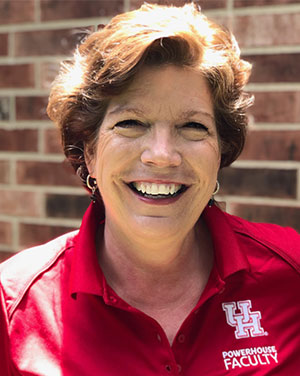
Ramona Mateer
Program Director, teachHOUSTON STEM Interactive
Master Teacher, teachHOUSTON, Department of Mathematics, University of Houston
Ramona Mateer, a University of Houston alumna, earned an M.Ed. in Science Curriculum
and Technology (University of Texas). She is a former junior high school science teacher
and instructional coach. In her free time, she cycles, reads, and enjoys Nintendo
Switch online gaming.
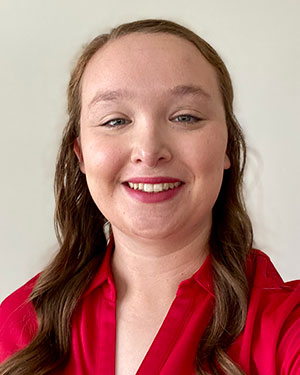
Meghan DiBacco
Physics Teacher, Cinco Ranch High School, Katy ISD.
University of Houston, College of Natural Sciences and Mathematics, teachHOUSTON Alumna, Geophysics Major
Ms. DiBacco is a proud two-time graduate of the University of Houston. She obtained
her bachelor's degree in geophysics, with minors in mathematics and geology, and is
an alumna of the teachHOUSTON Program. She is a physics teacher at Cinco Ranch High School and completed
her Master of Science in geophysics in December. Ms. DiBacco has participated in numerous
UH STEM camps, and she is excited to work with students and teachHOUSTON undergraduates as a camp leader. In her free time, she enjoys being outdoors
and learning how to build robots.

Stephen Medel
Physics Major, Mathematics Minor, teachHOUSTON Preservice Teacher, University of Houston, College of Natural Sciences and
Mathematics
Mr. Medel is an undergraduate at the University of Houston majoring in physics and
minoring in mathematics. He will be student teaching this fall at Dobie High School.
During his free time, he enjoys spending time with his adorable dog, Murphy, and playing
some tabletop and board games.
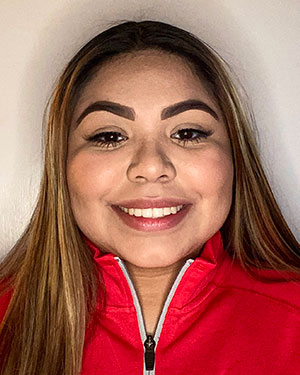
Yaneli Ruiz-Gonzalez
Biochemistry Major, Chemistry Minor, teachHOUSTON Preservice Teacher, University of Houston, College of Natural Sciences and
Mathematics
Ms. Ruiz-Gonzalez is an undergraduate at the University of Houston majoring in biochemistry
and minoring in chemistry. A senior in the teachHOUSTON program, she is passionate about sharing her love of science with students
while preparing them for their future endeavors and enjoys collaborating with other
STEM professionals. In her free time, she likes to do anything that has to do with
arts and crafts or playing video games.
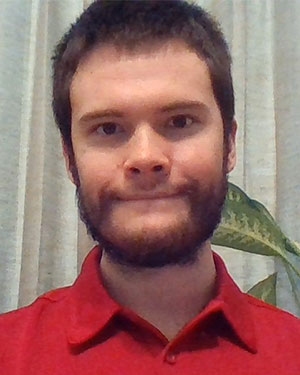
Michael Broderick
Mathematics Major, teachHOUSTON Preservice Teacher, University of Houston, College of Natural Sciences and
Mathematics
Mr. Broderick is an undergraduate at the University of Houston majoring in mathematics.
He is a senior in the teachHOUSTON program. In his free time, he enjoys playing strategic video games and tabletop
board games.
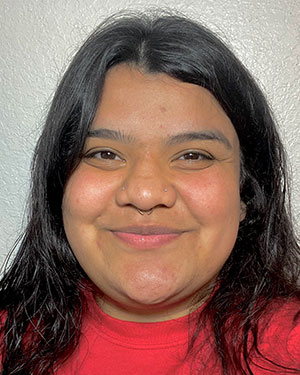
Jaqueline Barron
Biology Major, Anthropology Minor, teachHOUSTON Preservice Teacher, University of
Houston, College of Natural Sciences and Mathematics
Ms. Barron is an undergraduate at the University of Houston majoring in biology and
minoring in anthropology. She is in her first semester in the teachHOUSTON program. In her free time, she likes to draw, pick up new hobbies, hike, and
travel.
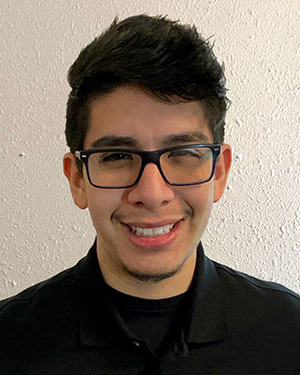
Brian Gonzales
Biology Major, teachHOUSTON Preservice Teacher, University of Houston, College of Natural Sciences and
Mathematics
teachHOUSTON STEM Interactive Video Editor
Mr. Gonzales is an undergraduate student at the University of Houston. He will be
student teaching in the fall and would like to teach either biology or anatomy and
physiology once he receives his teaching certification. In his free time, he enjoys
listening to artists like twenty one pilots or Billie Eilish, building Lego Star Wars
sets, and practicing photography at the park.
- https://ptable.com/?lang=en#Properties
- https://chemistrygod.com/bohr-atomic-model
- https://www.teachengineering.org/activities/view/cub_mix_lesson1_activity1
- https://sciencenotes.org/2016-2017-colorful-periodic-table-118-element-names/
- https://www.bensound.com/royalty-free-music/track/evolution-epic-nature
- https://www.schoolmykids.com/learn/interactive-periodic-table/ar-argon
- https://houstonpbs.pbslearningmedia.org/resource/nvhe.sci.chemistry.reactive/what-makes-an-element-reactive/
- https://www.youtube.com/watch?v=_lNF3_30lUE
- https://phet.colorado.edu/sims/html/build-an-atom/latest/build-an-atom_en.html
- https://www.nanooze.org/atom-fun-facts/
- https://www.sciencenewsforstudents.org/article/scientists-say-atom
- https://www.ck12.org/book/ck-12-physical-science-for-middle-school/section/5.2/
- https://www.livescience.com/37206-atom-definition.html
- https://kidsactivitiesblog.com/7833/atom-for-kids/
- https://abilenetx.gov/976/Periodic-Table